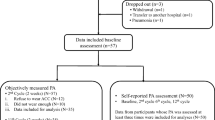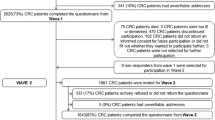Abstract
Purpose
The purpose of this study was to investigate the physical activity (PA) of colorectal cancer (CRC) survivors during chemotherapy and to explain it based on the theory of planned behavior (TPB). In addition, the effects of planning, past physical activity (P-PA), and self-efficacy on the PA of CRC survivors were analyzed.
Methods
CRC survivors were recruited in a third-grade hospital of Changchun via a convenience sampling method. All survivors were asked to complete self-report questionnaires assessing medical and demographic variables, PA, constructs from the TPB, P-PA, planning, and self-efficacy.
Results
A total of 174 CRC survivors were included in this study. Only 7.5% (13) of these CRC survivors had sufficient PA, and 32.2% (56) of CRC survivors were completely sedentary. Gender, education level, working status, residential location, method of payment for medical expenses, and cancer stage were all associated with PA in these patients (P < 0.05). The path model was able to explain 54% (R2 = 0.54) of the PA variance in these CRC survivors. P-PA had the greatest impact on PA during chemotherapy, and P-PA affected PA both directly and indirectly through planning.
Conclusions
Insufficient PA in CRC survivors was associated with a variety of factors, with P-PA having the greatest impact on this outcome. The results of this study suggest that attention must be paid to survivors who had exhibited insufficient PA prior to initial diagnosis.


Similar content being viewed by others
References
Torre LA, Bray F, Siegel RL, Ferlay J, Lortet-Tieulent J, Jemal A (2015) Global cancer statistics, 2012. CA Cancer J Clin 65(2):87–108
Oncology Society of Chinese Medical Association, Medical Administration and Hospital Administration, National Health and Family Planning Commission of the People’s Republic of China (2015) Criteria for diagnosis and treatment of colorectal cancer (2015 Edition) [J]. Chin J Pract Surg 35(11):1177–1191
Siegel R, DeSantis C, Virgo K, Stein K, Mariotto A, Smith T, Cooper D, Gansler T, Lerro C, Fedewa S, Lin C, Leach C, Cannady RS, Cho H, Scoppa S, Hachey M, Kirch R, Jemal A, Ward E (2012) Cancer treatment and survivorship statistics, 2012. CA Cancer J Clin 62(4):220–241
Brenner H, Bouvier AM, Foschi R, Hackl M, Larsen IK, Lemmens V, Mangone L, Francisci S (2012) Progress in colorectal cancer survival in Europe from the late 1980s to the early 21st century: the EUROCARE study. Int J Cancer 131(7):1649–1658
Sankaranarayanan R, Swaminathan R, Brenner H, Chen K, Chia KS, Chen JG, Law SC, Ahn YO, Xiang YB, Yeole BB, Shin HR, Shanta V, Woo ZH, Martin N, Sumitsawan Y, Sriplung H, Barboza AO, Eser S, Nene BM, Suwanrungruang K, Jayalekshmi P, Dikshit R, Wabinga H, Esteban DB, Laudico A, Bhurgri Y, Bah E, Al-Hamdan N (2010) Cancer survival in Africa, Asia, and Central America: a population-based study. Lancet Oncol 11(2):165–173
Kosmider S, Lipton L (2007) Adjuvant therapies for colorectal cancer. World J Gastroenterol 13(28):3799–3805
Williams GR, Nyrop KA, Deal AM, Muss HB, Sanoff HK (2015) Self-directed physical activity intervention in older adults undergoing adjuvant chemotherapy for colorectal cancer: design of a randomized controlled trial. Contemp Clin Trials 42:90–97
Winningham ML (2001) Strategies for managing cancer-related fatigue syndrome: a rehabilitation approach. Cancer 92(4 Suppl):988–997
Skinner TL, Peeters GG, Croci I, Bell KR, Burton NW, Chambers SK, Bolam KA (2016) Impact of a brief exercise program on the physical and psychosocial health of prostate cancer survivors: a pilot study. Asia Pac J Clin Oncol 12(3):225–234
Kirkham AA, Bland KA, Sayyari S, Campbell KL, Davis MK (2016) Clinically relevant physical benefits of exercise interventions in breast cancer survivors. Curr Oncol Rep 18(2):12
Adamsen L, Quist M, Andersen C, Møller T, Herrstedt J, Kronborg D, Baadsgaard MT, Vistisen K, Midtgaard J, Christiansen B, Stage M, Kronborg MT, Rørth M (2009) Effect of a multimodal high intensity exercise intervention in cancer patients undergoing chemotherapy: randomised controlled trial. BMJ 339:b3410
Adamsen L, Midtgaard J, Rorth M, Borregaard N, Andersen C, Quist M, Møller T, Zacho M, Madsen JK, Knutsen L (2003) Feasibility, physical capacity, and health benefits of a multidimensional exercise program for cancer patients undergoing chemotherapy. Support Care Cancer 11(11):707–716
Quist M, Rorth M, Zacho M, Andersen C, Moeller T, Midtgaard J, Adamsen L (2006) High-intensity resistance and cardiovascular training improve physical capacity in cancer patients undergoing chemotherapy. Scand J Med Sci Sports 16(5):349–357
Ajzen I (1985) From intentions to actions: a theory of planned behavior. In: Kuhl J, Beckmann J (eds) Action control: from cognition to behavior. Springer, Heidelberg, pp 11–39
Conner M, Kirk SF, Cade JE, Barrett JH (2003) Environmental influences: factors influencing a woman’s decision to use dietary supplements. J Nutr 133(6):1978S–1982s
Taymoori P, Molina Y, Roshani D (2015) Effects of a randomized controlled trial to increase repeat mammography screening in Iranian women. Cancer Nurs 38(4):288–296
Nguyen MN, Potvin L, Otis J (1997) Regular exercise in 30- to 60-year-old men: combining the stages-of-change model and the theory of planned behavior to identify determinants for targeting heart health interventions. J Community Health 22(4):233–246
Ajzen I, Fishbein M (2004) Questions raised by a reasoned action approach: comment on Ogden (2003). Health Psychol 23(4):431–434
Speed-Andrews AE, Rhodes RE, Blanchard CM, Culos-Reed SN, Friedenreich CM, Belanger LJ, Courneya KS (2012) Medical, demographic and social cognitive correlates of physical activity in a population-based sample of colorectal cancer survivors. Eur J Cancer Care (Engl) 21(2):187–196
Forbes CC, Blanchard CM, Mummery WK, Courneya KS (2014) A comparison of physical activity correlates across breast, prostate and colorectal cancer survivors in Nova Scotia, Canada. Support Care Cancer 22(4):891–903
Godin G, Shephard RJ (1985) A simple method to assess exercise behavior in the community. Can J Appl Sport Sci 10(3):141–146
Kushi LH, Doyle C, McCullough M, Rock CL, Demark-Wahnefried W, Bandera EV, Gapstur S, Patel AV, Andrews K, Gansler T (2012) American Cancer Society Guidelines on nutrition and physical activity for cancer prevention: reducing the risk of cancer with healthy food choices and physical activity. CA Cancer J Clin 62(1):30–67
Du M, Liang ML (2012) Moderating effects of coping strategies on job stress and wellness of sport and recreation managers. J Xi’an Phys Educ Univ 29(01):94–100
Ajzen I (2006) Constructing a theory of planned behavior questionnaire. University of Massachusetts. www.people.umass.edu/aizen/pdf/tpb.measurement.pdf. Accessed 05 June 2016
Benisovich SV, Rossi JS, Norman GJ, Nigg CR (1998) Development of a multidimensional measure of exercise self-efficacy. Poster presented at the Society of Behavioral Medicine (SBM). New Orleans, LA
Benisovich SV, Rossi JS, Norman GJ, Nigg CR (1998) . A multidimensional approach to exercise self-efficacy: relationship with exercise behavior and attitudes towards exercise. Paper presented at the annual meeting of the New England Psychological Association, Boston, MA
Marcus BH, Selby VC, Niaura RS, Rossi JS (1992) Self-efficacy and the stages of exercise behavior change. Res Q Exerc Sport 63(1):60–66
Blanchard CM, Courneya KS, Stein K (2008) Cancer survivors’ adherence to lifestyle behavior recommendations and associations with health-related quality of life: results from the American Cancer Society’s SCS-II. J Clin Oncol 26(13):2198–2204
Peddle CJ, Au HJ, Courneya KS (2008) Associations between exercise, quality of life, and fatigue in colorectal cancer survivors. Dis Colon Rectum 51(8):1242–1248
Wang DQ, Yang FG, Li GX, Liang Y, Yuang YY, Cao LN (2015) Relationship between resilience and health-promoting behaviors in rectal cancer patients receiving neoadjuvant therapy. J Nurs Sci 30(24):74–76
D’Andrea AP, Fernandez CA, Tannenbaum SL, Clarke TC, McClure LA, LeBlanc WG, Lee DJ (2014) Correlates of leisure time physical activity compliance in colorectal cancer survivors. Prev Med 62:78–82
Husson O, Mols F, Fransen MP, van de Poll-Franse LV, Ezendam NP (2015) Low subjective health literacy is associated with adverse health behaviors and worse health-related quality of life among colorectal cancer survivors: results from the profiles registry. Psychooncology 24(4):478–486
Peddle CJ, Plotnikoff RC, Wild TC, Au HJ, Courneya KS (2008) Medical, demographic, and psychosocial correlates of exercise in colorectal cancer survivors: an application of self-determination theory. Support Care Cancer 16(1):9–17
Forward SE (2009) The theory of planned behaviour: the role of descriptive norms and past behaviour in the prediction of drivers’ intentions to violate. Transport Res F-Traf 12(3):198–207
Norman P, Conner M, Bell R (2000) The theory of planned behaviour and exercise: evidence for the moderating role of past behaviour. Br J Health Psychol 5(3):249–261
Acknowledgments
The authors would like to show their deepest gratitude to their teachers who have provided them with valuable guidance.
Funding
This manuscript was financially supported by the National Natural Science Foundation of China (81570491)
Author information
Authors and Affiliations
Corresponding authors
Ethics declarations
Conflict of interest
The authors declare that they have no conflicts of interest.
Additional information
Publisher’s note
Springer Nature remains neutral with regard to jurisdictional claims in published maps and institutional affiliations.
Rights and permissions
About this article
Cite this article
Bao, Y., Chen, S., Jiang, R. et al. The physical activity of colorectal cancer survivors during chemotherapy. Support Care Cancer 28, 819–826 (2020). https://doi.org/10.1007/s00520-019-04873-3
Received:
Accepted:
Published:
Issue Date:
DOI: https://doi.org/10.1007/s00520-019-04873-3




